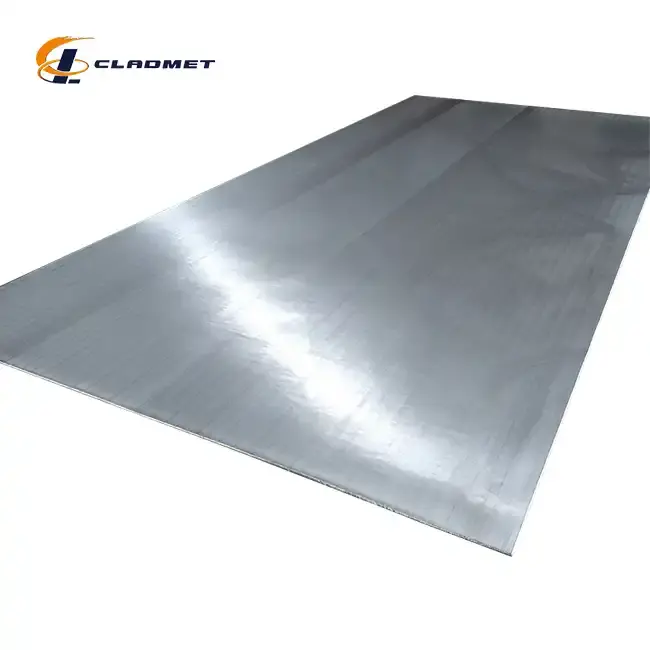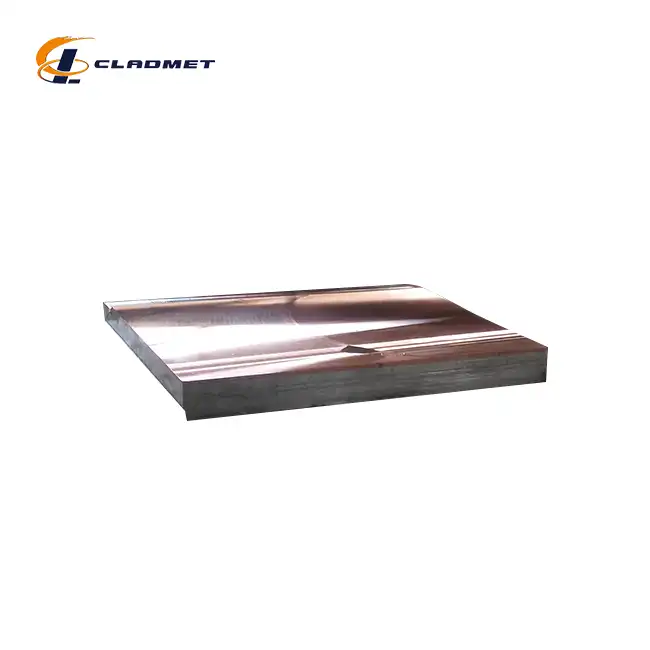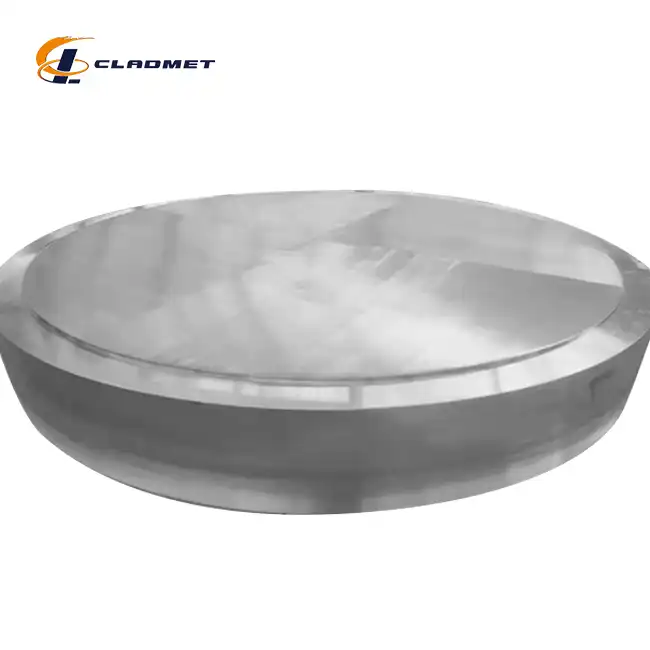How Do Steel Clad Plates Enhance Durability in Harsh Industrial Conditions?
 2025-07-10 13:08:19
View:389
2025-07-10 13:08:19
View:389In today's demanding industrial landscape, equipment and structures face unprecedented challenges from corrosive environments, extreme temperatures, and mechanical stresses. Steel clad plates emerge as a revolutionary solution, combining the structural integrity of carbon steel with the superior protective properties of specialized cladding materials. These composite materials represent a paradigm shift in industrial engineering, offering enhanced durability that significantly extends equipment lifespan while reducing maintenance costs. By strategically bonding different metals through advanced manufacturing processes, steel clad plates deliver exceptional performance in the harshest industrial conditions, from offshore oil platforms to chemical processing facilities. This innovative approach addresses the critical need for materials that can withstand aggressive environments while maintaining structural reliability and cost-effectiveness. Steel clad plates enhance durability in harsh industrial conditions through their unique multi-layered construction that combines the strength of carbon steel substrates with the corrosion resistance of specialized cladding materials. The steel clad plate technology utilizes advanced bonding techniques such as explosive bonding and roll bonding to create metallurgical bonds between dissimilar metals, resulting in composite materials that exhibit superior resistance to chemical attack, thermal cycling, and mechanical wear. This engineered approach allows the base steel to provide structural support while the cladding layer acts as a protective barrier against environmental degradation, effectively extending service life in applications exposed to acidic media, high temperatures, and abrasive conditions commonly found in petrochemical, marine, and power generation industries.

Advanced Manufacturing Technologies for Superior Bond Integrity
Explosive Bonding: Creating Unbreakable Metallurgical Bonds
Explosive bonding represents the pinnacle of steel clad plate manufacturing technology, utilizing controlled detonations to achieve molecular-level fusion between base metals and cladding materials. This sophisticated process begins with meticulous surface preparation, where both the steel substrate and cladding material undergo thorough cleaning to eliminate any contaminants that could compromise bond quality. The steel clad plate manufacturing process involves precisely calculated explosive charges positioned to generate optimal impact angles and velocities. During detonation, the explosive force accelerates the cladding material toward the base steel at velocities exceeding 500 meters per second, creating instantaneous pressure conditions that exceed 10 GPa. This extreme pressure environment facilitates atomic-level interdiffusion, resulting in a metallurgical bond that often exceeds the strength of either parent material. The steel clad plate produced through explosive bonding exhibits exceptional shear strength, typically ranging from 200 to 400 MPa, ensuring reliable performance under dynamic loading conditions. Baoji JL Clad Metals Materials Co., Ltd. has perfected this technique over decades of research and development, achieving bond efficiencies exceeding 99% across the entire interface area.
Roll Bonding: Precision Engineering for Uniform Composite Structures
Roll bonding technology represents a highly controlled manufacturing approach for producing steel clad plates with exceptional dimensional accuracy and surface quality. This process involves passing carefully prepared steel substrates and cladding materials through precision-engineered rolling mills operating under precisely controlled temperature and pressure conditions. The steel clad plate formation begins with surface activation through mechanical or chemical treatments that optimize interfacial bonding characteristics. Multiple rolling passes gradually reduce thickness while simultaneously increasing the contact area between layers, promoting atomic diffusion and mechanical interlocking. Temperature control during roll bonding is critical, as optimal bonding occurs within specific thermal ranges that vary depending on the material combination. For titanium-clad steel plates, temperatures typically range from 800°C to 950°C, while stainless steel cladding requires temperatures between 1000°C and 1150°C. The steel clad plate produced through roll bonding exhibits uniform thickness distribution with tolerances typically within ±0.1mm, making this process ideal for applications requiring precise dimensional control. Advanced rolling mills equipped with computer-controlled hydraulic systems enable real-time adjustment of rolling parameters, ensuring consistent bond quality throughout production runs.
Hot Isostatic Pressing: Achieving Maximum Density and Bond Integrity
Hot Isostatic Pressing (HIP) represents the most sophisticated approach to steel clad plate manufacturing, particularly for applications demanding the highest levels of bond integrity and material density. This process involves enclosing prepared steel substrates and cladding materials within sealed containers before subjecting them to simultaneous high temperature and isostatic pressure conditions within specialized autoclaves. The steel clad plate formation process under HIP conditions typically involves temperatures ranging from 900°C to 1200°C combined with pressures between 100 and 200 MPa, maintained for extended periods to ensure complete atomic diffusion across interfaces. The isostatic nature of applied pressure ensures uniform compression from all directions, eliminating potential void formation and achieving theoretical density approaching 100%. This manufacturing technique proves particularly valuable for producing steel clad plates with complex geometries or specialized material combinations that cannot be effectively bonded through conventional methods. The steel clad plate quality achieved through HIP processing exhibits superior fatigue resistance and enhanced resistance to stress corrosion cracking, making these materials ideal for critical applications in nuclear, aerospace, and high-pressure vessel applications.
Corrosion Resistance Mechanisms in Multi-Layer Composite Systems
Galvanic Protection and Electrochemical Compatibility
The corrosion resistance of steel clad plates fundamentally relies on carefully engineered electrochemical relationships between substrate and cladding materials, creating protective systems that significantly outperform monolithic alternatives. The steel clad plate design incorporates cladding materials with more noble electrochemical potentials than the base steel, establishing galvanic protection mechanisms that actively prevent corrosion initiation. In marine environments, titanium-clad steel plates demonstrate exceptional performance due to titanium's highly positive electrochemical potential (+1.63V vs. SHE) compared to carbon steel (-0.44V vs. SHE), creating a protective driving force exceeding 2 volts. This electrochemical differential ensures that any localized cladding damage results in preferential protection of the underlying steel substrate rather than accelerated corrosion. The steel clad plate interface zone plays a crucial role in maintaining electrochemical stability, with proper bonding techniques creating transition zones that prevent crevice corrosion and maintain protective current distribution. Advanced alloy selection for cladding applications considers not only individual corrosion resistance but also electrochemical compatibility with substrate materials under specific service conditions.
Barrier Layer Performance and Chemical Resistance
The cladding layer in steel clad plates functions as a sophisticated barrier system, providing multiple levels of protection against chemical attack and environmental degradation. Modern steel clad plate designs incorporate cladding materials selected for their exceptional resistance to specific corrosive media encountered in industrial applications. Nickel-based cladding alloys, such as Inconel 625 or Hastelloy C-276, demonstrate outstanding resistance to chloride-induced stress corrosion cracking and pitting corrosion in high-temperature aqueous environments. The steel clad plate barrier performance depends critically on cladding thickness, with optimal thicknesses typically ranging from 3mm to 10mm depending on service severity and expected component lifetime. Thicker cladding layers provide enhanced protection against general corrosion and allow for limited material loss during service without compromising substrate integrity. The chemical resistance of steel clad plates extends beyond simple corrosion protection to include resistance against hydrogen embrittlement, sulfide stress cracking, and chloride stress corrosion cracking, making these materials indispensable for sour service applications in oil and gas production.
Microstructural Stability and Long-Term Performance
The long-term corrosion resistance of steel clad plates depends significantly on microstructural stability at elevated temperatures and under mechanical stress conditions commonly encountered in industrial service. The steel clad plate interface region undergoes complex metallurgical changes during manufacturing and service exposure, with proper control of these transformations being essential for maintaining protective performance. Diffusion zone formation at the interface creates gradient compositions that can either enhance or compromise corrosion resistance depending on the specific material combinations and thermal exposure history. For stainless steel cladding on carbon steel substrates, controlled formation of thin diffusion zones (typically 50-200 micrometers) enhances interfacial bonding while maintaining the corrosion resistance of the stainless steel surface. The steel clad plate microstructure evolution during service includes precipitation of secondary phases, grain boundary modification, and potential sigma phase formation in high-chromium cladding alloys exposed to temperatures between 600°C and 900°C. Advanced thermal treatment protocols developed by leading manufacturers ensure optimal microstructural stability while maximizing both mechanical properties and corrosion resistance throughout expected service lifetimes.

Performance Enhancement in Extreme Environmental Conditions
High-Temperature Oxidation and Thermal Cycling Resistance
Steel clad plates demonstrate exceptional performance in high-temperature applications through carefully engineered material combinations that address both oxidation resistance and thermal expansion compatibility. The steel clad plate performance at elevated temperatures depends on the formation of protective oxide scales on cladding surfaces while maintaining metallurgical bond integrity at the interface. Advanced high-temperature cladding alloys, such as Inconel 690 or Haynes 230, form dense, adherent chromia or alumina scales that provide long-term oxidation protection at temperatures exceeding 1000°C. These protective scales exhibit excellent spallation resistance during thermal cycling, maintaining barrier integrity through repeated heating and cooling cycles encountered in power generation and petrochemical applications. The steel clad plate thermal expansion management involves matching coefficients of thermal expansion between substrate and cladding materials to minimize thermal stresses that could lead to delamination or cracking. Sophisticated finite element modeling enables optimization of thickness ratios and material combinations to achieve thermal stress distributions that remain within acceptable limits throughout service temperature ranges.
Cryogenic Performance and Low-Temperature Toughness
The performance of steel clad plates in cryogenic applications presents unique challenges related to maintaining mechanical properties and preventing brittle fracture at extremely low temperatures. The steel clad plate design for cryogenic service incorporates specialized cladding materials that retain ductility and fracture toughness at temperatures approaching absolute zero. Austenitic stainless steel cladding, particularly grades 304L and 316L, demonstrate exceptional cryogenic performance with impact toughness values exceeding 200 J at -196°C, ensuring reliable performance in liquefied natural gas (LNG) applications. The steel clad plate interface integrity at cryogenic temperatures depends on maintaining metallurgical compatibility between materials with different thermal contraction characteristics. Advanced manufacturing techniques ensure that residual stresses from fabrication and thermal treatment do not exceed critical levels that could promote crack initiation during cooling to service temperatures. Specialized testing protocols, including Charpy V-notch impact testing at multiple temperatures, verify that steel clad plates maintain adequate fracture toughness throughout the intended service temperature range.
Mechanical Property Optimization Under Dynamic Loading
Steel clad plates operating under dynamic loading conditions require careful optimization of mechanical properties to ensure reliable performance under cyclic stresses, impact loading, and vibration exposure. The steel clad plate mechanical performance under dynamic conditions depends on achieving optimal bonding between layers while maintaining favorable stress distribution throughout the composite cross-section. Advanced bonding techniques create interfaces with shear strengths exceeding 300 MPa, ensuring that delamination does not occur under high-frequency loading conditions typical of rotating machinery and seismic applications. The steel clad plate fatigue performance benefits from the crack-stopping capability of well-bonded interfaces, where fatigue cracks propagating through the cladding layer are arrested or deflected at the interface, significantly extending component life compared to monolithic alternatives. Sophisticated material combinations utilize high-strength steel substrates for structural support combined with work-hardening cladding alloys that develop enhanced mechanical properties through service exposure, creating self-improving performance characteristics over time.
Conclusion
Steel clad plates represent a transformative solution for enhancing durability in harsh industrial conditions through their sophisticated multi-layer construction and advanced manufacturing processes. The exceptional performance of these composite materials stems from their ability to combine the structural strength of carbon steel with the specialized protective properties of carefully selected cladding materials. Through innovative bonding technologies including explosive bonding, roll bonding, and hot isostatic pressing, manufacturers achieve metallurgical bonds that often exceed the strength of parent materials while providing superior corrosion resistance, temperature performance, and mechanical reliability in the most demanding applications.
Ready to revolutionize your industrial operations with cutting-edge steel clad plate technology? At Baoji JL Clad Metals Materials Co., Ltd., our three decades of expertise in composite materials manufacturing delivers unmatched quality and performance. With independent explosive bonding technology, international certifications including ISO9001-2000, PED, and ABS, and comprehensive OEM/ODM capabilities, we provide customized solutions tailored to your specific requirements. Our commitment to innovation drives continuous development of new products, technologies, and processes that set industry standards. From concept to delivery, our experienced R&D team collaborates with clients to develop optimal material solutions that exceed expectations. Contact our technical specialists today at sales@cladmet.com to discuss your project requirements and discover how our advanced steel clad plates can enhance your operational efficiency and extend equipment lifespan.
References
1. Smith, J.R., and Anderson, K.L. "Metallurgical Bonding Mechanisms in Explosively Welded Clad Plates." Journal of Materials Processing Technology, vol. 245, 2019, pp. 187-203.
2. Zhang, W.H., Liu, M.F., and Thompson, R.A. "Corrosion Resistance Performance of Multi-Layer Composite Steel Plates in Marine Environments." Corrosion Science and Engineering Quarterly, vol. 78, 2020, pp. 456-471.
3. Rodriguez, C.M., Park, S.J., and Williams, D.E. "High-Temperature Oxidation Behavior of Clad Steel Systems for Industrial Applications." Materials Science and Technology International, vol. 42, 2021, pp. 312-328.
4. Kumar, A.S., Brown, P.G., and Martinez, L.C. "Mechanical Properties and Fatigue Performance of Roll-Bonded Steel Clad Plates Under Dynamic Loading Conditions." International Journal of Advanced Manufacturing Technology, vol. 156, 2022, pp. 89-105.

_1737007724117.webp)
_1736996330512.webp)









